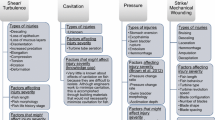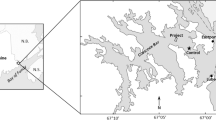Abstract
Passage of fishes through hydropower turbines and water pumping stations may cause mortal injury as the result of exposure to blade strike impact. Laboratory trials of simulated blade strike on two morphologically distinct fishes, American eel (Anguilla rostrata) and bluegill sunfish (Lepomis macrochirus) were undertaken to assess injury and mortality rates. We hypothesized that bluegill would have comparable rates of injury and mortality to other laterally compressed fishes while anguilliform American eel would be more resistant to injury. American eel had low observed mortality rates at the highest velocity tested (13.6 m/s), but many fish were observed with vertebral fractures which we categorized as functionally dead individuals. Bluegill were more susceptible to blade strike with high rates of mortality regardless of blade thickness, velocity, or impact conditions (location, angle, or fish orientation). These data have broadened our understanding of the range of responses among entrained fishes exposed to blade strike and represent species with low (American eel) and high (bluegill) susceptibility to injury and mortality. Our blade strike data can help inform safer turbine designs or prioritization of pumps that minimize traumatic injury and mortality of fishes during non-volitional passage through hydropower turbines or water pumping stations.



Similar content being viewed by others
References
Baumgartner, L. J., N. K. Reynoldson, L. Cameron & J. Stanger, 2009. Effects of irrigation pumps on riverine fish. Fisheries Management and Ecology 16: 429–437.
Bevelhimer, M. S., B. M. Pracheil, A. M. Fortner, R. K. Saylor & K. L. Deck, 2019. Mortality and injury assessment for three species of fish exposed to simulated turbine blade strike. Canadian Journal of Fisheries and Aquatic Sciences. https://doi.org/10.1139/cjfas-2018-0386.
Binder, T. R., S. J. Cooke & S. G. Hinch, 2011. Physiological specializations of different fish groups: fish migrations. In Farrell, A. P., J. J. Cech Jr., J. G. Richards & E. D. Stevens (eds), Encyclopedia of Fish Physiology: From Genome to Environment. Elsevier Inc., San Diego, CA: 1921–1952.
Brainerd, E. L. & S. N. Patek, 1998. Vertebral column morphology, C-start curvature, and the evolution of mechanical defenses in Tetraodontiform fishes. Copeia 1998: 971–984.
Čada, G. F., 2001. The development of advanced hydroelectric turbines to improve fish passage survival. Fisheries 26: 14–23.
Campbell, I., 2007. Chi squared and Fisher–Irwin tests of two-by-two tables with small sample recommendations. Statistics in Medicine 26: 3661–3675.
Carr, J. W. & F. G. Whoriskey, 2008. Migration of silver American eels past a hydroelectric dam and through a coastal zone. Fisheries Management and Ecology 15: 393–400.
Collar, D. C. & P. C. Wainwright, 2009. Ecomorphology of centrarchid fishes. In Cooke, S. & D. Philipp (eds), Centrachid Fishes: Diversity, Biology and Conservation. Blackwell Publishing Ltd, West Sussex: 70–89.
Colotelo, A. H., A. E. Goldman, K. A. Wagner, R. S. Brown, Z. D. Deng & M. C. Richmond, 2017. A comparison of metrics to evaluate the effects of hydro-facility passage stressors on fish. Environmental Reviews 25: 1–11.
Cooke, S. & D. Philipp, 2009. Centrarchid Fishes: Diversity. Wiley-Blackwell Publishing, Biology and Conservation.
Coutant, C. C. & R. R. Whitney, 2000. Fish Behavior in Relation to Passage through Hydropower Turbines: a Review. Transactions of the American Fisheries Society 129: 351–380.
EPRI (Electric Power Research Institute), 2008. Electric Power Research Institute. Evaluation of the Effects of Turbine Blade Leading Edge Design on Fish Survival. EPRI Report No. 1014937. Palo Alto, CA.
EPRI (Electric Power Research Institute), 2011. Electric Power Research Institute. 2010 Tests Examining Survival of Fish Struck By Turbine Blades. EPRI Report No. 1024684. Palo Alto, CA.
Eyler, S. M., S. A. Welsh, D. R. Smith & M. M. Rockey, 2016. Downstream passage and impact of turbine shutdowns on survival of silver American eels at five hydroelectric dams on the Shenandoah River. Transactions of the American Fisheries Society 145: 964–976.
Froese, R., & D. Pauly, 2019. Fishbase. Fishbase. https://www.fishbase.se/search.php.
Fu, T., Z. D. Deng, J. P. Duncan, D. Zhou, T. J. Carlson, G. E. Johnson & H. Hou, 2016. Assessing hydraulic conditions through Francis turbines using an autonomous sensor device. Renewable Energy Elsevier Ltd 99: 1244–1252.
Grubbs, R. D. & R. T. Kraus, 2010. Fish migration. In Breed, M. D. & J. Moore (eds), Encyclopedia of Animal Behavior. Elsevier Academic Press, San Diego, CA: 715–724.
Haro, A., 2014. Anguillidae: freshwater eels. In Warren, M. L. & B. M. Burr (eds), Freshwater Fishes of North America: Petromyzontidae to Catostomidae. Johns Hopkins University Press, Baltimore: 313–331.
Helfman, G. S., B. B. Collette, D. E. Facey & B. W. Bowen, 2009. The Diversity of Fishes: Biology, Evolution, and Ecology. Wiley-Blackwell Publishing, West Sussex.
Helfrich, L. A., R. Bark, C. R. Liston, D. L. Weigmann & B. Mefford, 2004. Live transport of striped bass and rainbow trout using a Hidrostal pump. Journal of the World Aquaculture Society 35: 268–273.
Hilbe, J. M., 2016. Practical Guide to Logistic Regression. Chapman and Hall/CRC, Boca Raton.
Hostetter, N. J., A. F. Evans, D. D. Roby, K. Collis, M. Hawbecker, B. P. Sandford, D. E. Thompson & F. J. Loge, 2011. Relationship of external fish condition to pathogen prevalence and out-migration survival in juvenile steelhead. Transactions of the American Fisheries Society 140: 1158–1171.
Hou, H., Z. Deng, J. Martinez, T. Fu, J. Duncan, G. Johnson, J. Lu, J. Skalski, R. Townsend & L. Tan, 2018. A hydropower biological evaluation toolset (HBET) for characterizing hydraulic conditions and impacts of hydro-structures on fish. Energies 11: 990–1002.
Jager, H. I., B. Elrod, N. Samu, R. A. McManamay & B. T. Smith, 2013. ESA Protection for the American Eel: Implications for U.S. Hydropower. ORNL/TM-2013/361. Oak Ridge, TN.
Javahery, S., H. Nekoubin & A. H. Moradlu, 2012. Effect of anaesthesia with clove oil in fish (review). Fish Physiology and Biochemistry 38: 1545–1552.
Keefer, M. L., G. A. Taylor, D. F. Garletts, C. K. Helms, G. A. Gauthier, T. M. Pierce & C. C. Caudill, 2013. High-head dams affect downstream fish passage timing and survival in the Middlefork Williamette River. River Research and Applications 29: 483–492.
Long, J. H. & K. S. Nipper, 1996. The importance of body stiffness in undulatory propulsion. American Zoologist 36: 678–694.
Martinez, J. J., Z. D. Deng, P. S. Titzler, J. P. Duncan, J. Lu, R. P. Mueller, C. Tian, B. A. Trumbo, M. L. Ahmann & J. F. Renholds, 2019. Hydraulic and biological characterization of a large Kaplan turbine. Renewable Energy 131: 240–249.
McIntyre, P. B., C. R. Liermann, E. Childress, E. J. Hamann, J. D. Hogan, S. R. Januchowski-Hartley, A. A. Koning, T. M. Neeson, D. L. Oele & B. M. Pracheil, 2016. Conservation of migratory fishes in freshwater ecosystems. In Closs, G. P., M. Krkosek & J. D. Olden (eds), Conservation of Freshwater Fishes. Cambridge University Press, Cambridge: 324–360.
McNabb, C. D., C. R. Liston & S. M. Borthwick, 2003. Passage of juvenile chinook salmon and other fish species through Archimedes lifts and a Hidrostal Pump at Red Bluff, California. Transactions of the American Fisheries Society 132: 326–334.
Mueller, M., J. Pander & J. Geist, 2017. Evaluation of external fish injury caused by hydropower plants based on a novel field-based protocol. Fisheries Management and Ecology 24: 240–255.
Nelson, J. S., T. C. Grande & M. V. H. Wilson, 2016. Fishes of the World. Wiley, Hoboken, NJ.
ORNL (Oak Ridge National Laboratory), 2019. National Hydropower Asset Assessment Program (NHAAP). ORNL, Oak Ridge.
Pracheil, B. M., C. R. DeRolph, M. P. Schramm & M. S. Bevelhimer, 2016a. A fish-eye view of riverine hydropower systems: the current understanding of the biological response to turbine passage. Reviews in Fish Biology and Fisheries 26: 153–167.
Pracheil, B. M., R. A. McManamay, M. S. Bevelhimer, C. R. DeRolph & G. F. Čada, 2016b. A traits-based approach for prioritizing species for monitoring and surrogacy selection. Endangered Species Research 31: 243–258.
Pracheil, B. M., G. E. Mestl & M. A. Pegg, 2015. Movement through dams facilitates population connectivity in a large river. River Research and Applications 31: 517–525.
R Core Team, 2018. R: a Language and Environment for Statistical Computing. R Foundation for Statistical Computing Computing, Vienna, Austria. http://www.r-project.org.
Richmond, M. C., J. A. Serkowski, C. Radowski, B. Strickler, M. Weisbeck & C. Dotson, 2014. Computational tools to assess turbine biological performance. Hydroreview 33: 1–6.
Ritz, C., F. Baty, J. C. Streibig & D. Gerhard, 2015. Dose-response analysis using R. PLoS ONE 10: 1–13.
Sneddon, L. U., 2012. Clinical anesthesia and analgesia. Journal of Exotic Pet Medicine 21: 32–43.
Swain, D. P., 1992. The functional basis of natural selection for vertebral traits of larvae in the stickleback Gasterosteus aculeatus. Evolution 46: 987–997.
Turnpenny, A. W. H., 1998. Mechanisms of fish damage in low head turbines: an experimental appraisal. In Jungwirth, M., S. Schmutz & S. Weiss (eds), Fish Migration and Fish Bypasses. Blackwell Publishing Ltd, Malden, MA: 300–314.
Turnpenny, A. W. H., M. H. Davis, J. M. Fleming & J. K. Davies, 1992. Experimental Studies Relating to the Passage of Fish and Shrimps Through Tidal Power Turbines. WIT Press, Southampton.
Tytell, E. D. & G. V. Lauder, 2008. Hydrodynamics of the escape response in bluegill sunfish, Lepomis macrochirus. Journal of Experimental Biology 211: 3359–3369.
Uria-Martinez, R., M. M. Johnson, P. W. O’Connor, N. M. Samu, A. M. Witt, H. Battey, T. Welch, M. Bonnet & S. Wagoner, 2018. 2017 Hydropower Market Report. ORNL, Oak Ridge, TN.
USACE (United States Army Corp of Engineers), 2018. National Inventory of Dams. CorpsMap, US Army Corp of Engineers., http://nid.usace.army.mil/cm_apex/f?p=838:5:0::NO.
van Esch, B. P. M., 2012. Fish injury and mortality during passage through pumping stations. Journal of Fluids Engineering 134: 071302.
van Esch, B. P. M., I. L. Y. Spierts & K. Tierney, 2014. Validation of a model to predict fish passage mortality in pumping stations. Canadian Journal of Fisheries and Aquatic Sciences 71: 1910–1923.
Acknowledgements
This research was funded by the US Department of Energy’s Waterpower Program to Oak Ridge National Laboratory (ORNL)/UT-Battelle, LLC under Contract No. DE-AC05-00OR22725. Animal use approval was granted by the ORNL Animal Care and Use Committee [protocol #0444]. Fish used in this study were obtained from Southeastern Pond Management in Jackson, TN, and Delaware Valley Fish Company in, Norristown, PA. Special thanks to Rebecca Brink, Miles Mobley, and Clara Layzer for assistance in the lab and Gary Johnson (Pacific Northwest National Laboratory, PNNL) and Shelaine Curd (ORNL) for project management. Reviews from Brenda Pracheil (ORNL) and Brett Pflugrath (PNNL) strengthened the content of this manuscript.
Author information
Authors and Affiliations
Corresponding author
Additional information
Handling editor: Eric Larson
Publisher's Note
Springer Nature remains neutral with regard to jurisdictional claims in published maps and institutional affiliations.
This manuscript has been authored by UT-Battelle, LLC under Contract No. DE-AC05-00OR22725 with the US Department of Energy. The United States Government retains and the publisher, by accepting the article for publication, acknowledges that the United States Government retains a non-exclusive, paid-up, irrevocable, worldwide license to publish or reproduce the published form of this manuscript, or allow others to do so, for United States Government purposes. The Department of Energy will provide public access to these results of federally sponsored research in accordance with the DOE Public Access Plan (http://energy.gov/downloads/doe-public-access-plan).
Rights and permissions
About this article
Cite this article
Saylor, R., Fortner, A. & Bevelhimer, M. Quantifying mortality and injury susceptibility for two morphologically disparate fishes exposed to simulated turbine blade strike. Hydrobiologia 842, 55–75 (2019). https://doi.org/10.1007/s10750-019-04026-x
Received:
Revised:
Accepted:
Published:
Issue Date:
DOI: https://doi.org/10.1007/s10750-019-04026-x




